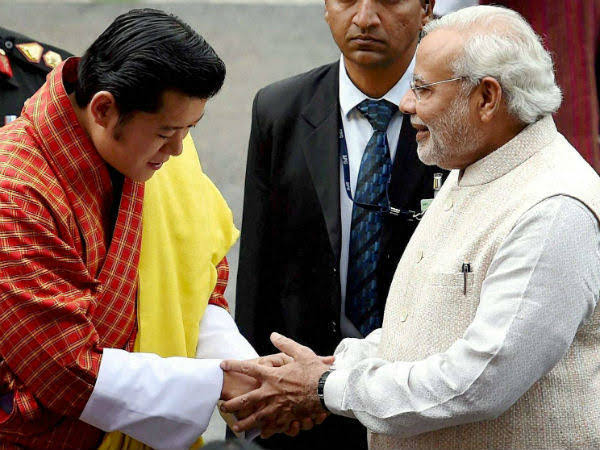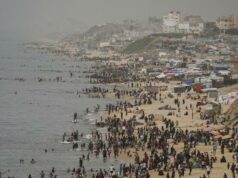India – Bhutan friendship is eternal

Bhutan’s king, Jigme Khesar Namgyel Wangchuk, arrived in India on November 3 for an eight-day visit. The visit began in the adjacent Indian state of Assam, a part of which lies directly south of Bhutan. The queen Jetsun Pema and their two children are also accompanying him.The royals reached New Delhi on Sunday and met PM Modi on 06 Nov.
The Oxford educated King is totally for Bhutan and fully conversant with the needs of people of South Asia. He was born in Kathmandu.
In 2002, as crown prince, still in his early twenties, he delivered a speech at the United Nations. He has frequently visited India and is acquainted with its top echelons. The queen, like her husband with a formal education in international relations, and a passion for art history, twice attended boarding schools in India. She was briefly at St Joseph’s Convent in Kalimpong and, later, at The Lawrence School, Sanawar; her photos as a high-school student there are showcased in the best-known photo studio in the nearby hill town of Kasauli.
The visit has set policy circles in many capitals and media of interested countries to a frenzy of conjecture. Beijing is absolutely tense. Every one is fully aware that India is ever ready to provide total help but does not interfere in the internal affairs of of Bhutan, Bangladesh, Nepal, Maldives, Myanmar and Sri Lanka.
Also they too are aware that they are attached with an umbilical like chord with India. Hence no outside power Can drive any permanent wedge between them.
China has no borders with Bhutan.
However being in forcible occupation of Tibet a free country, Beijing has been trying to establish direct diplomatic relationship with Bhutan since long. China even tried to occupy Bhutanese territory in area called Doklam but was prevented from doing so by timely actions of Indian Army. Since then a smarting Beijing is enticing Bhutan to establish a formal diplomatic relations.
There after China will try and coax Bhutan to formally invite China to a trilateral table to sort out the problem of what is essentially a Tibet Bhutan border. Doklam, is located at the tri junction of India’s eastern Sikkim state, northwest Bhutan, and south western Tibet.
Alongside several contentious matters which includes, vacation of occupied areas in Ladhak and Shakshagam by PLA, demarcation of Indo Tibet Border, China Tibet Border and Tibet Bhutan border, Doklam gives jitters to Beijing. It was in Doklam area where in 2017 the PLA was forced to STOP its salami slicing and then “stared down “ after a tense period of several weeks.
In Doklam, unlike the India-Tibetan border along Ladakh far to the northwest, or Indo Tibetan border along eastern Arunachal Pradesh, the dispute here is not directly with India. It’s between Bhutan and China. China being in occupation of Tibet claims a little less than 300sq-km of Bhutan’s territory.
But the location is so strategic from India’s perspective and, evidently, China’s – that any ceding of territory here by Bhutan to China would bring China closer to the crucial Chicken’s Neck or the Siliguri Corridor, an approximately 60km long and 20-odd km wide strip that links India’s mainland to its far-east.
A crisis here could snip nearly a seventh of India’s landmass. It may be noted here that the Tibet Govt in exile has no such dispute with Bhutan over Doklam, so actually China has no claim whatsoever over Doklam.
In 2017, India sent several hundred troops, and bulldozers, across the border into Doklam to demolish illegal construction by the PLA and prevent Chinese troops from constructing a road there.
India also keeps a sharp eye on another region, in Bhutan’s northern border with Tibet now under control of PLA and not too far from Doklam: about 500sq-km patch in Jakarlung and Pasamlung. As with India’s LAC disputes with China, Bhutan’s border disputes can be traced to China’s forced occupation from Tibet from 1950 onwards, and the effective negation of several border markers decided upon decades earlier by treaty, with Tibet.
Best friends forever?
Indian Bhutanese treaty has thus far ensured that Bhutan and China do not formally have diplomatic relations. India is duty bound to provide full External security to Bhutan. IMTRAT, or the Indian Military Training Team, is an active presence in Bhutan.
Its commanding officer is also part diplomat, part chief trainer, and part counsel. This past June, IMTRAT celebrated International Day of Yoga, by holding a public display along with Royal Bhutan Army, the kingdom’s police, and select citizenry. A message on the platform X (formerly Twitter) by Indian Army’s public relations arm proclaimed this as signifying the “everlasting spirit of friendship between #India and #Bhutan.”
China and few other interested parties are trying all the possibility that Bhutan might form a lasting friendship with China. Absence of formal diplomatic relations between Bhutan and China have dampened that concern. So India too is pursuing national interest as it sees fit.
China is just not giving up. In May 2023, the “Expert Group” on the “Bhutan-China Boundary Issue” held its 12th meeting, in Thimphu. It was quickly followed by the 13th meeting in August, held in Beijing. A declaration urged speed for a memorandum of understanding for what is called the “Three Step Roadmap,” although the steps remain hazy to the world-at-large. Negotiators established a “joint technical team.”
This was followed in late October by the “25th Round of Boundary Talks” in Beijing. The previous such round was held back in 2016. Negotiators from Bhutan and China signed a “Cooperation Agreement” on the “Responsibilities and Functions of the Joint Technical Team (JTT) on the Delimitation and Demarcation of the Bhutan-China Boundary.” The talks, according to a Bhutan foreign ministry statement, were held in a “warm and friendly” atmosphere. There was again mention of the mysterious “Three Step Roadmap.”
Stage one
India’s firm action in the settling of the Doklam border issue, even as China was clearly involved in the unsettling of Doklam, has been tormenting Beijing since long. In fact this led to its disastrous action in Galwan where PLA lost 40 soldiers as killed and another 40 wounded. India lost 20 All ranks.
Thereafter Xi has been forced to change Commander of Western Theatre four times in less than two years. Now even the Defence Minster and the top two of Rocket Forces too have fallen down.
Bhutan and India have steadily tried to ensure socio-economic development of Bhutan at a rapid pace while controlling access to the country to protect its fragile population — with 770,000 people in an area quarter the size of Bangladesh — and a calibrated ethno-religious mix of cultures and languages. Indeed, economic prosperity could ensure Bhutan doesn’t lose its top crop of youngsters to destinations in USA and Australia.
The approach extends to education. There is an active project, developed with direct patronage of the king, that is fine-tuning an academic approach — an example is the Bhutan Baccalaureate — that, among other things, seeks to holistically mix science with humanities and respect for the environment. There is talk of enhancing the country into a regional knowledge and research hub.
Branching out
India has, for decades, remained Bhutan’s economic mainstay, with tourists, trade, and a range of investment/grants that include financing and know-how for major hydroelectric projects — which permits Bhutan to export surplus power back to India.
Now Bhutan increasingly sees Bangladesh also as a trading destination. Indeed, the two countries have signed a sprawling preferential trade agreement that permits bilateral duty-free access to numerous goods. Bangladesh has offered its major ports to Bhutan as exim hubs.
Here India provides overland transhipment facilities: goods between Bhutan and Bangladesh travel through Indian territory. Overall trade is picking up. Electricity is seen as a major future Bhutanese export to Bangladesh.



